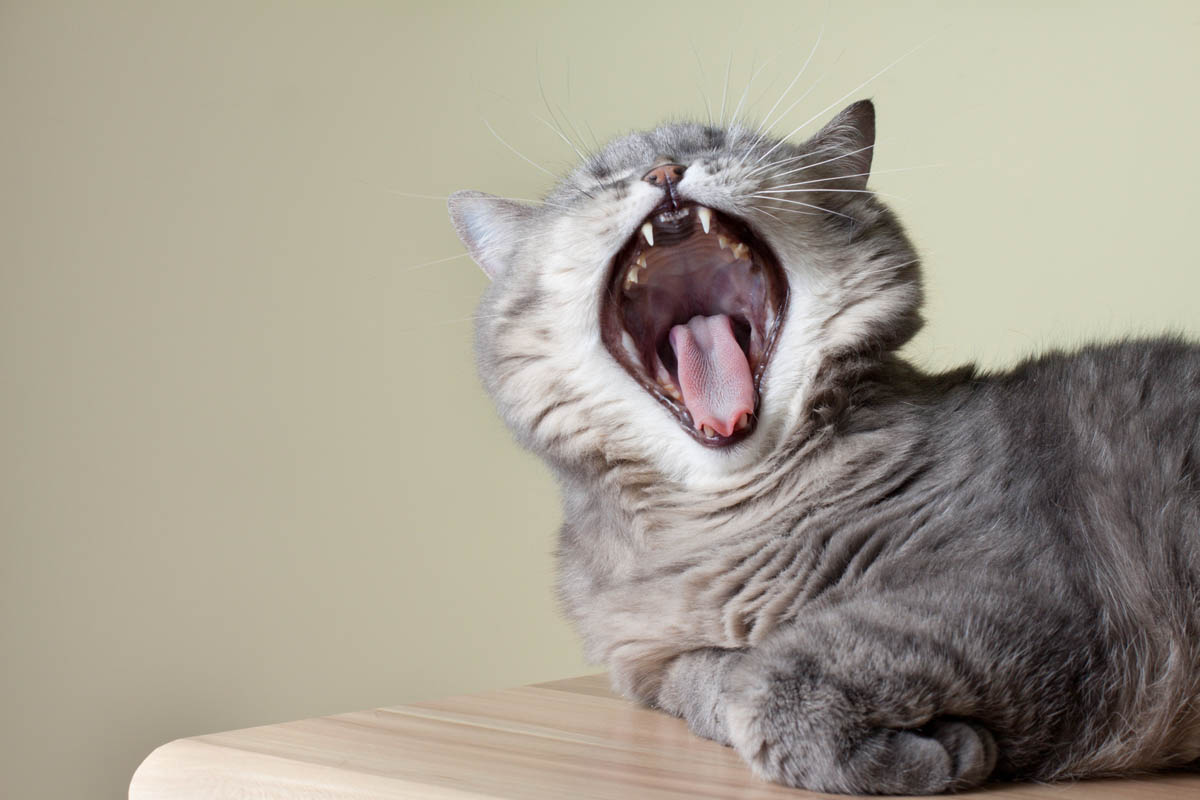A healthy cat’s breath should not be offensive, overly strong breath is not normal always has an underlying cause which warrants investigation.
Causes
Bad breath can originate in the mouth or be due to several systemic diseases. Gingivitis and gum disease are by far the most common causes of bad breath in cats.
Oral:
- Stomatitis
- Gingivitis
- Gum disease
- Tooth abscess
- Foreign body such as a stick or bone trapped in the roof of the mouth
- Strong smelling foods
- Teething in kittens
- Nasopharyngeal polyps
Diseased teeth and gums can have a serious impact on many organ systems. The gums have a rich blood supply, bacteria from the mouth can enter the bloodstream through lesions in the gums and travel to other organs including the liver, heart, and kidneys, which can lead to organ damage or failure.
Systemic:
- Diabetes
- Reflux
- Respiratory tract infections
- Kidney disease
- Liver disease
- Cancers
- Gastrointestinal problems (obstructions, cancer, infection)
Symptoms
The main symptom is an unpleasant odour from the mouth, other symptoms of diseases of the oral cavity include:
- Redness along the gum lines and bleeding (gingivitis or gum disease)
- Unwillingness to eat due to pain.
- Drooling
- Poor coat condition, pain and discomfort can result in a reluctance to groom
- Tartar (calculus) deposits on the teeth
- Pawing at the mouth (foreign body)
- Loss of weight
Symptoms of systemic disease:
These can vary depending on the underlying pathology but may include increased thirst and urination which are associated with kidney disease and diabetes, weight loss, lethargy, diarrhea, vomiting, oral lumps or ulcers and facial swelling.
Diagnosis
Your veterinarian will perform a complete physical examination of your cat, including a careful examination of the mouth to look for signs of gingivitis, gum disease, lodged foreign body, dental abscess and tumours.
Diagnostic workup:
- Baseline tests: Biochemical profile, complete blood count, and urinalysis to evaluate organ function and to check for infection.
- Dental X-rays: An oral examination can only evaluate the exposed teeth and gums, diagnostic imaging is needed to check the dental structures below the gumline.
- Ultrasound: To evaluate the size of the liver and kidneys, look for foreign bodies in the gastrointestinal tract.
- Endoscopy: A thin tube with a camera on the end is used to evaluate the digestive tract for signs of damage due to reflux or look for foreign bodies, tumours.
Treatment
Treatment for bad breath depends on the underlying cause of bad breath, gingivitis and gum disease will require dental treatment to remove calculus from the teeth above and below the gum line and extract any diseased teeth which cannot be saved.
Additional therapies will depend on the underlying cause.
- Tumours and polyps: Surgery to remove polyps or tumours, chemotherapy as a follow up to cancer. Sadly the prognosis for oral tumours is poor.
- Liver disease: Treatment depends on the cause. Surgery for some cases of a portosystemic shunt. Dietary modification and supportive care.
- Kidney disease: Low protein diet and supportive care such as fluids to manage dehydration, anti-nausea medication and phosphorous binders.
- Stomatitis: Corticosteroids and long-term antibiotics for stomatitis. Removal of the teeth may be necessary for severe cases.
- Dental abscess: Lance, flush and remove dead tissue. Antibiotics as a follow-up.
- Reflux: Low protein, low-fat diets, along with more frequent, small meals. Medications to protect the esophagus.
Prevention
Prevention is the key when it comes to your cat’s health, follow these steps to better oral health for your cat.
Regularly check the teeth and gums:
- Make a habit of checking your cat’s teeth once a month and you notice any redness, bleeding, lumps, bumps, bad breath see your veterinarian immediately. If your cat doesn’t like it, don’t force the issue. Try again the next day, just a few seconds at a time to get him used to have his mouth and teeth handled. Reward him afterwards.
Dental care:
- Brush your cat’s teeth once a day and/or feed raw chicken necks/chunks of raw beef. Start when your cat is young, so he gets used to having his teeth cleaned. Plaque is a sticky film that builds up on the cat’s teeth, if it is not removed, by brushing and/or diet, it forms tartar, which is a hardened, calcified deposit that requires removal by a veterinarian.
Limit canned food:
- Avoid an exclusive diet of canned food. Cut up chunks of human-grade beef, cheap cuts such as chuck steak are perfect. This allows your cat to really chew the food, keeping his jaw and bones strong.
Feed raw chicken wings or necks:
- These are a great way to reduce plaque and tartar formation. Most people recommend one or two chicken necks or wings twice a week. Never feed your cat cooked bones of any kind as they are more brittle which can cause them to splinter.
Schedule an annual check-up:
- Make sure your cat sees a veterinarian once a year for a check-up to stay on top of any possible health and dental problems.

